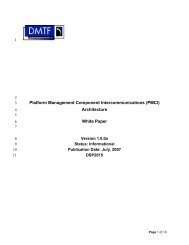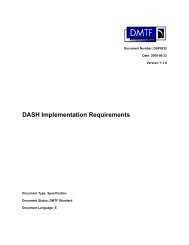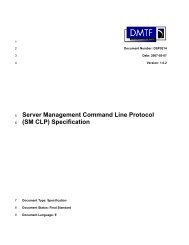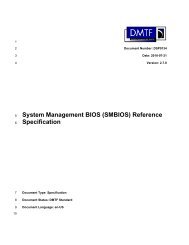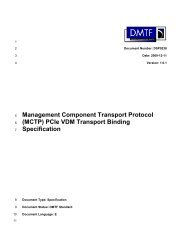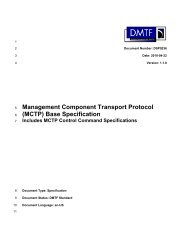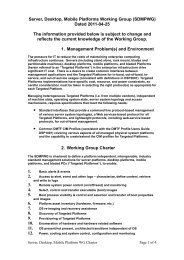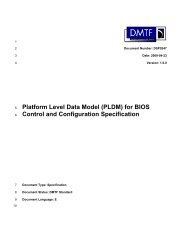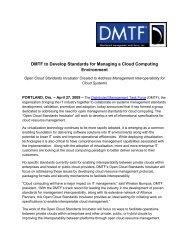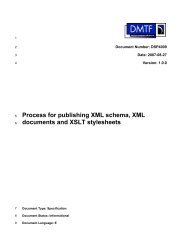ASF Specification v2.0 DSP0136 - DMTF
ASF Specification v2.0 DSP0136 - DMTF
ASF Specification v2.0 DSP0136 - DMTF
Create successful ePaper yourself
Turn your PDF publications into a flip-book with our unique Google optimized e-Paper software.
Alert Standard Format (<strong>ASF</strong>) <strong>Specification</strong> <strong>v2.0</strong><br />
<strong>DMTF</strong> Document <strong>DSP0136</strong><br />
Contents Type Offset Value<br />
Message Tag 1 byte 05h This 1-byte field is used to match request-response pairs. This<br />
value is copied into the response message when one is generated<br />
in a request-response interaction, e.g. the Presence<br />
Ping/Presence Pong pair. When a duplicate message is received,<br />
i.e. one with the same Message Tag, the consumer of the<br />
message determines whether the message is accepted or<br />
rejected. For example, an alert-sending device might be designed<br />
to respond to all Presence Ping messages received, or to keep<br />
track of recent Presence Ping messages and only respond to<br />
those with unique Message Tag values. See below for more<br />
information.<br />
Note: A value of 255 (FFh) indicates that the associated message<br />
is not a request-response type message.<br />
Reserved 1 byte 06h Reserved for future definition by this specification, set to 0.<br />
Data Length 1 byte 07h This 1-byte field contains the byte length of the message’s<br />
variable-length Data field.<br />
Data<br />
N<br />
bytes<br />
08h<br />
Data associated with a particular Message Type, number of bytes<br />
is specified by Data Length.<br />
Using the Message Tag Field<br />
Many of the RMCP messages are of the request/response type:<br />
• A Presence Ping sent from a management console requests that the client respond with a<br />
Presence Pong<br />
• A Capabilities Request from a management console requests that the client respond with a<br />
Capabilities Response<br />
• A System State Request from a management console requests that the client respond with a<br />
System State Response.<br />
For each of these message pairs, the RMCP Data block’s Message Tag field provides a method<br />
to bind a response to its associated request.<br />
For example, a management console sends a Presence Ping with the Message Tag field set to<br />
12h to a managed client. The client’s alert-sending device copies the Message Tag field value<br />
from the message received into the associated Presence Pong response prior to transmitting that<br />
message. When the management console receives the Presence Pong, the console can quickly<br />
map the message to its associated Presence Ping by matching the Message Tag fields.<br />
3.2.3 RMCP Security-Extensions Protocol (RSP)<br />
RMCP Security-Extensions Protocol (RSP) provides integrity and anti-replay services for RMCP<br />
messages. When RSP is used, an entire RMCP message is encapsulated in an RSP header and<br />
trailer (shown as the shaded areas in the table below).<br />
• An RSP header is inserted between the UDP header and the RMCP header and its presence<br />
is identified by the use of the RMCP security extensions UDP port number (0298h).<br />
• An RSP trailer is located following the end of the RMCP message’s Data block (i.e., security<br />
extensions are applied above the UDP layer).<br />
The table illustrates which fields of the RSP header, RMCP message, and RSP trailer are<br />
protected by the integrity service.<br />
Contents Type Offset Value<br />
Source Port 2 Bytes 22h<br />
Destination Port 2 Bytes 24h 0298h<br />
UDP Length 2 Bytes 26h<br />
UDP Checksum 2 Bytes 28h<br />
UDP Header<br />
<strong>DSP0136</strong> 23 April 2003 Page 23 of 94



